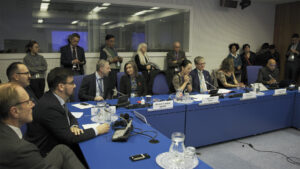“The goal was to show the effects and repercussions of drug policy worldwide, but with a special focus on Latin America.” Video and article about the Drug Policy Museum in Mexico City by Karina Muscarina and Fanny Pineda, partner of the Drugreporter.
The fourth stop of the Drug Policy Museum was Mexico City, following stops in London, Montreal, and New York. The exhibition lasted just 3 days, and featured more than 80 works from 26 artists from around the world, including 12 Mexicans. The goal was to show the effects and repercussions of drug policy worldwide, but with a special focus on Latin America.
This art and cultural exposition included discussion panels organised by ReverdeSer Colectivo. Interactive discussions and workshops were held by experts from different areas including politics, human rights, public health, artists, activists, social justice, and families who are looking for their missing relatives. In these interventions we got a glimpse into the reality of life in Mexico, in addition to offering different options and strategies to move towards a new drug policy that strives for peace, education, and social reconstruction.
At the beginning of the exposition was a timeline showing the changes in Mexican drug policy. An emblematic example about how to deal with the drug phenomenon was in the thirties under Lázaro Cárdenas` government. The director of the public health department was Leopoldo Salazar Viniegra, who promoted a more compassionate approach. By giving special attention to drug users and pointing out the different effects of substances on people, he showed that not all drug use is problematic. Dr. Salazar explained that since that time, prohibition has triggered a series of conflicts of interests where the police and the black market have the highest profits. He proposed dealing with the drug problem from a public health approach, not from a security one.
He managed to start marijuana, opium, and cocaine dispensaries legally operated by health personnel, however the United States started to put pressure on the Mexican government, who consequently closed them. Prohibition and drug criminalisation started then, and as a result the people who use drugs were criminalised and imprisoned, the drug market profits increased hugely, and the corruption between dealers and the police began to become evident. These and other examples exposed how drug policy based on prohibition is more dangerous than the drugs themselves.
Currently, drug policies in Mexico are still prohibitionist. In 2006 the “War on Drugs” was declared by president Felipe Calderón, and since then Mexico has endured the most violent of decades. 2017 was the most violent year in Mexican history. To face the phenomenon of drugs with strategies that include armed forces has resulted in many deaths, forced displacement, forced disappearance, incarceration of people who use drugs, and exorbitant profits to people who are involved, including the government and organised criminals.
This scenario shows the necessity of changing how we speak about this theme, and the importance of exposing alternative policies in countries like Portugal, Uruguay, and Switzerland. We should start thinking about how to build Mexico without violence and without human rights violations. By integrating a lot of perspectives from the people who have been affected by drug policies, we can start to develop strategies to allow integrative speech about how to repair the damage and give support to people who have been affected.
The drug policy museum showed relevant issues that should be addressed by drug policy, as well as giving a chance to the most affected people to raise their voices in offering solutions for the future. It is important to mention that the event was free to the general public and 3,000 people attended the exhibition, discussion panels, and workshops.
In addition, the report: “Corruption kills: why Mexico needs an international mechanism to fight impunity” was launched at the museum. Produced by the Open Society Justice Initiative, the report is an analysis of the collusion between state actors and organised crime.
We thank the Open Society Foundation for helping us to achieve this important exhibition.
Video by Karina Muscarina
Article by Fanny Pineda




